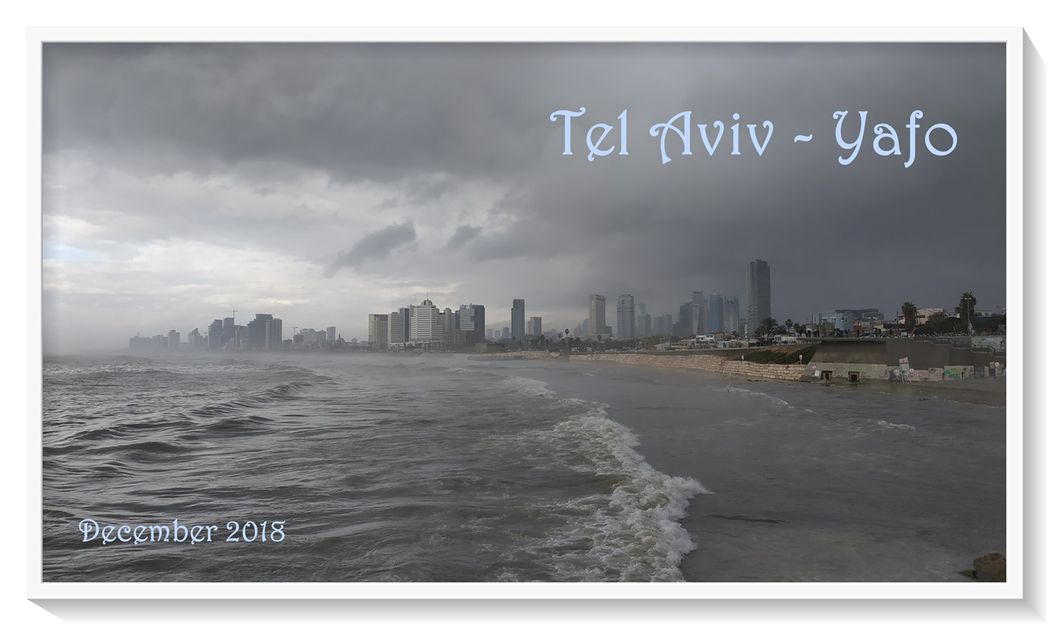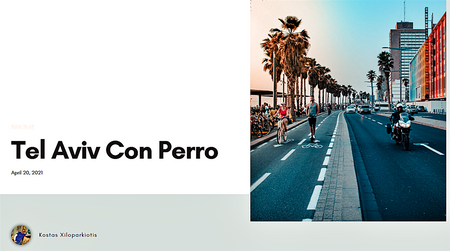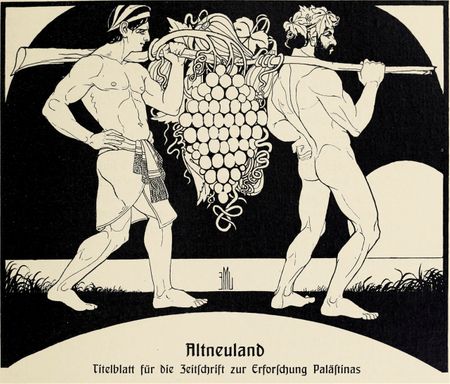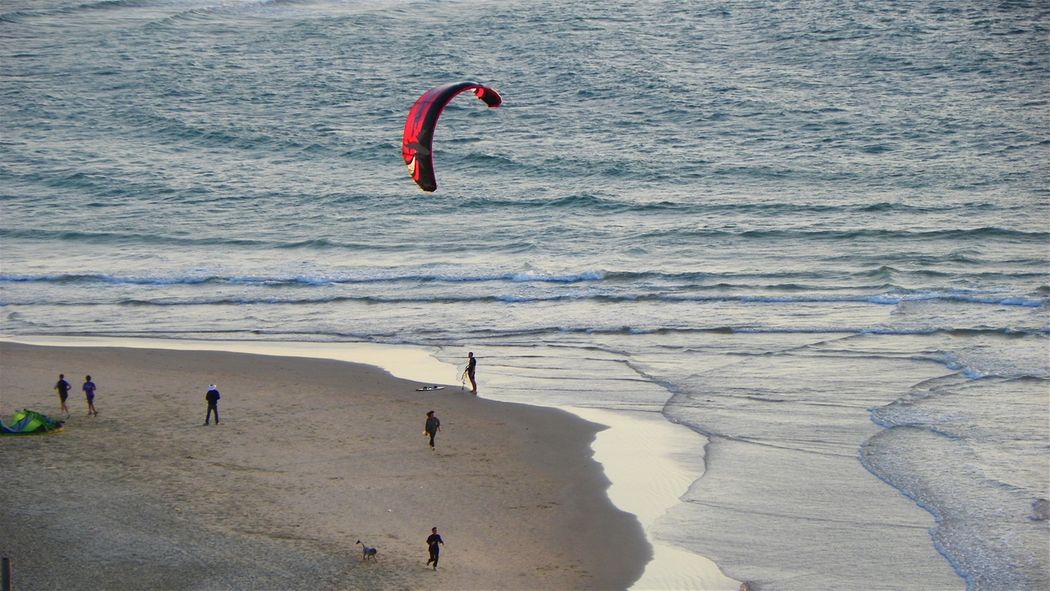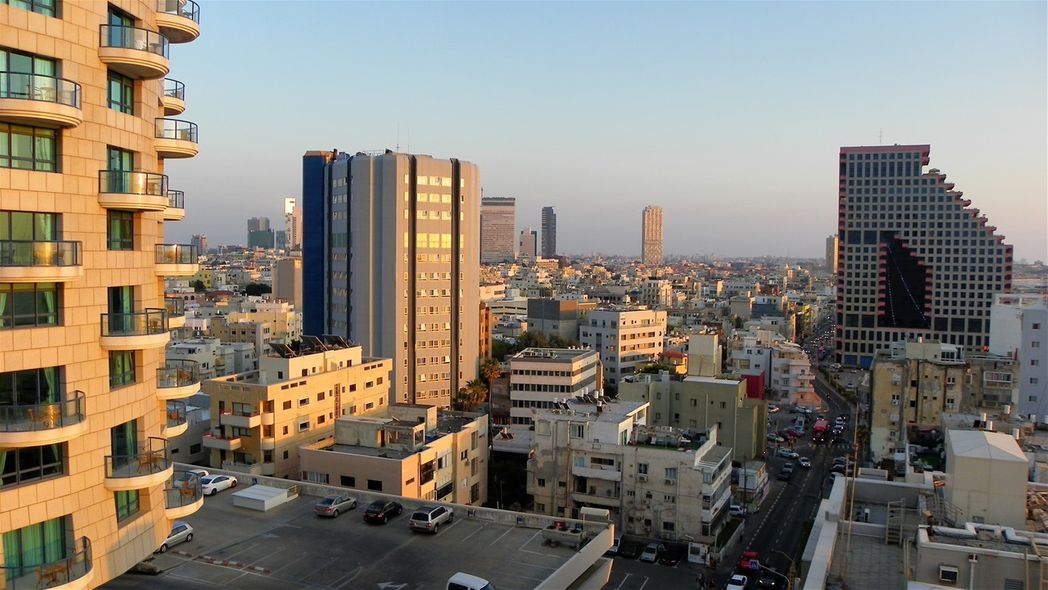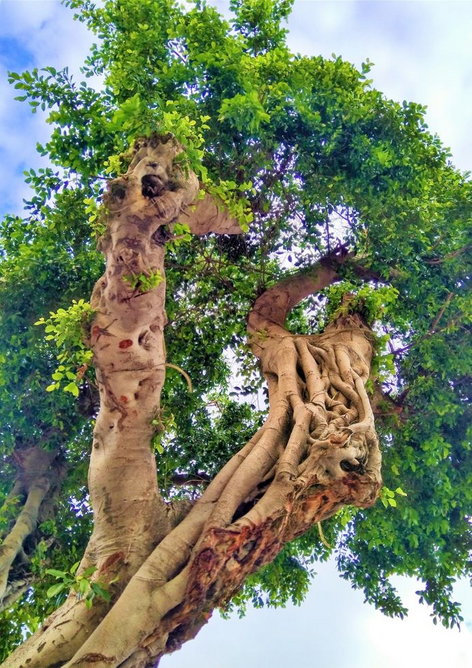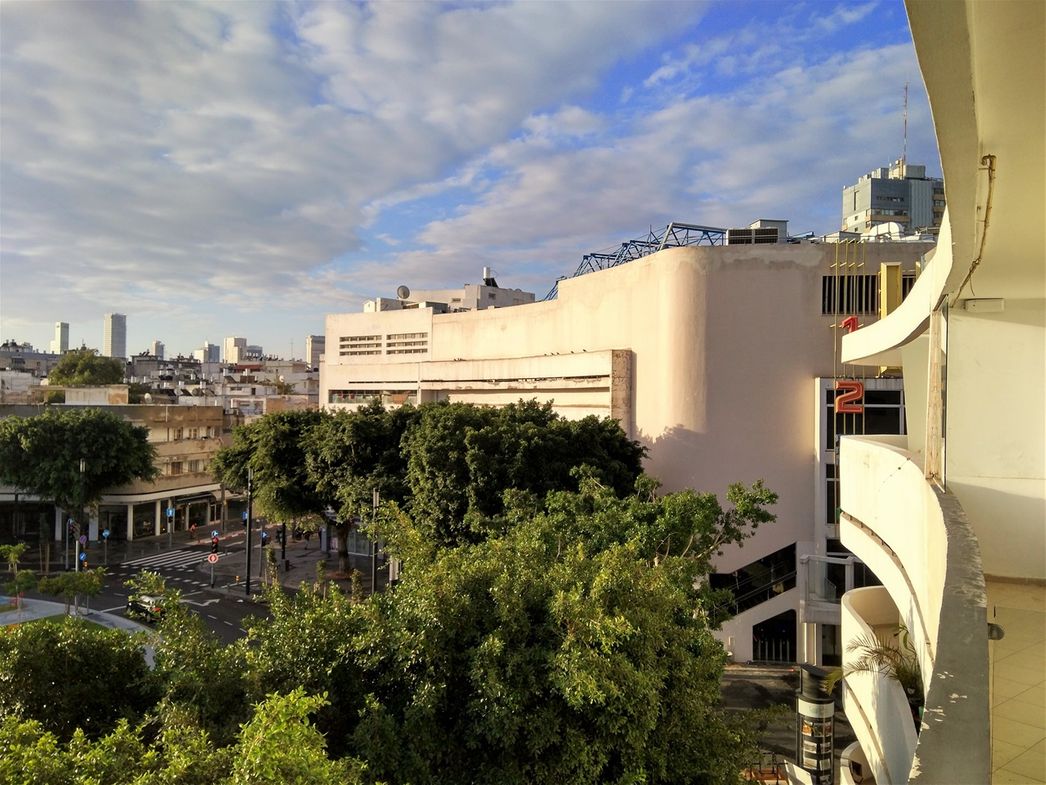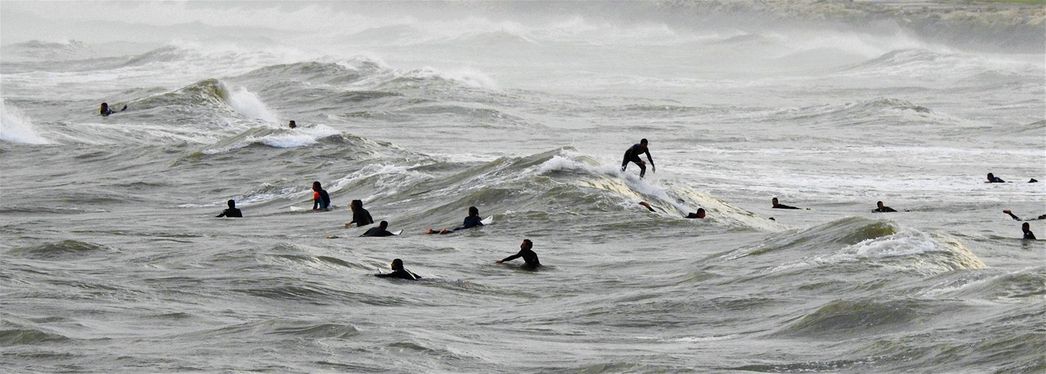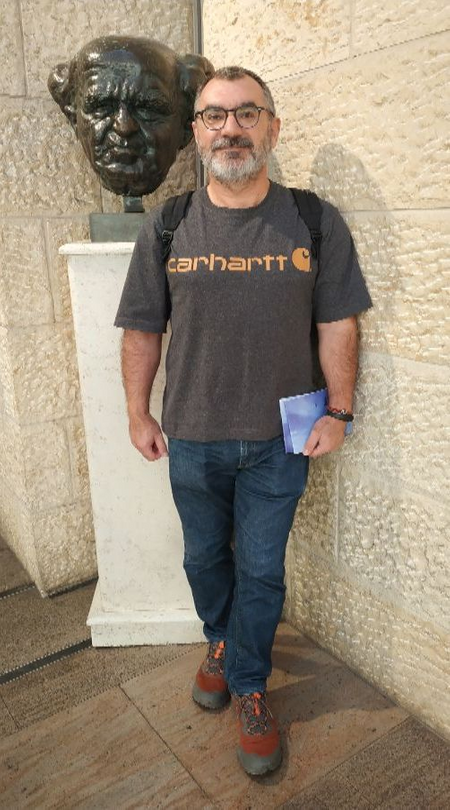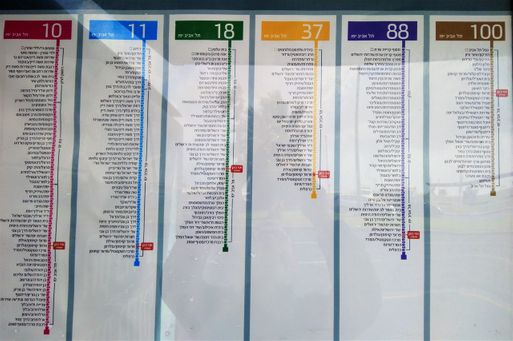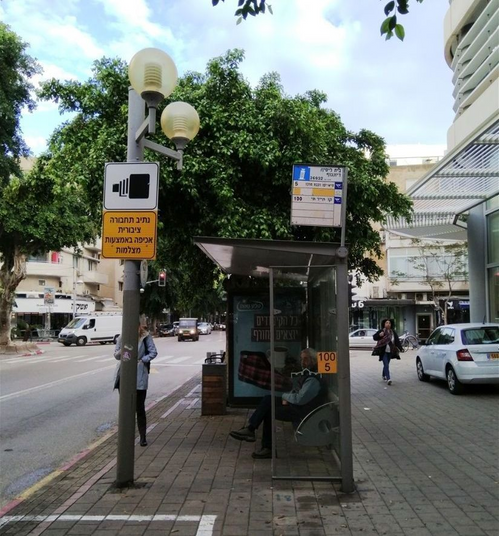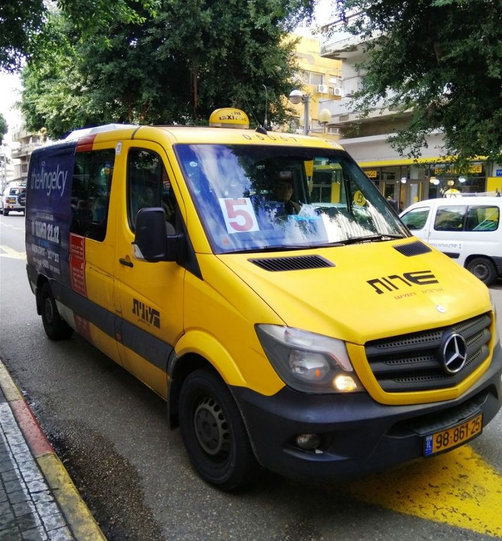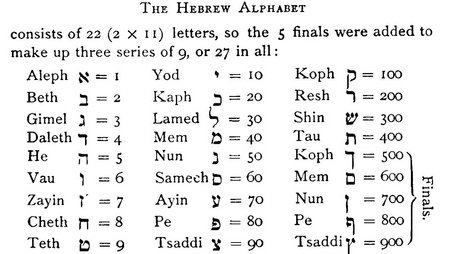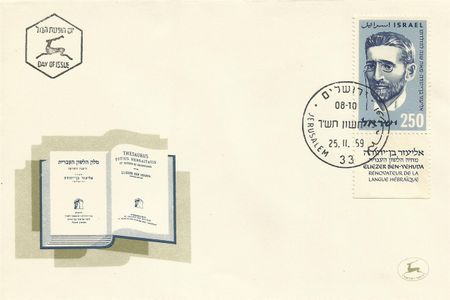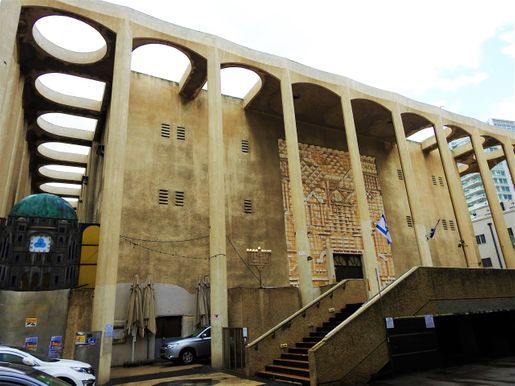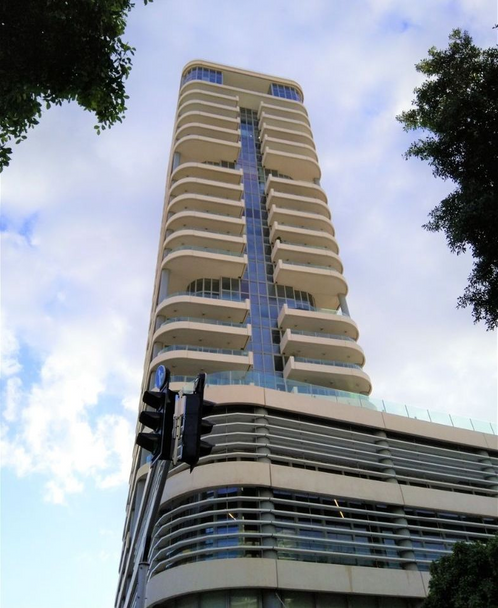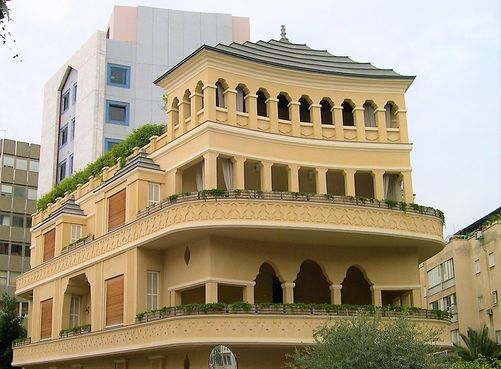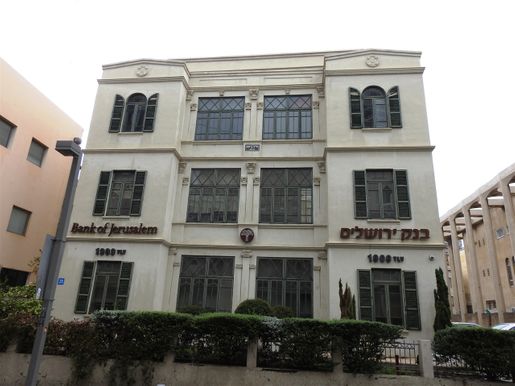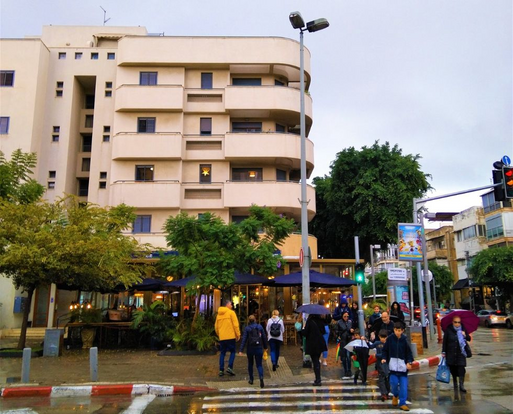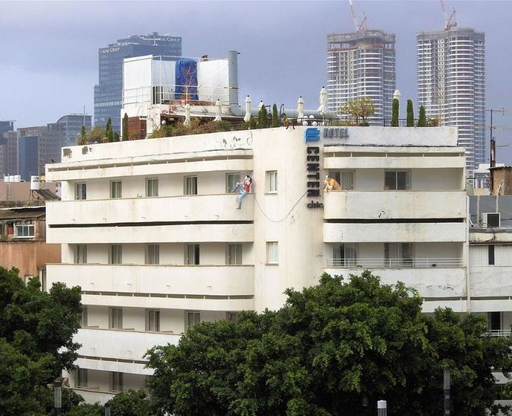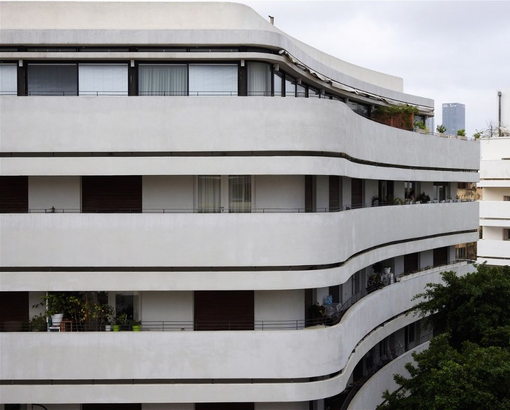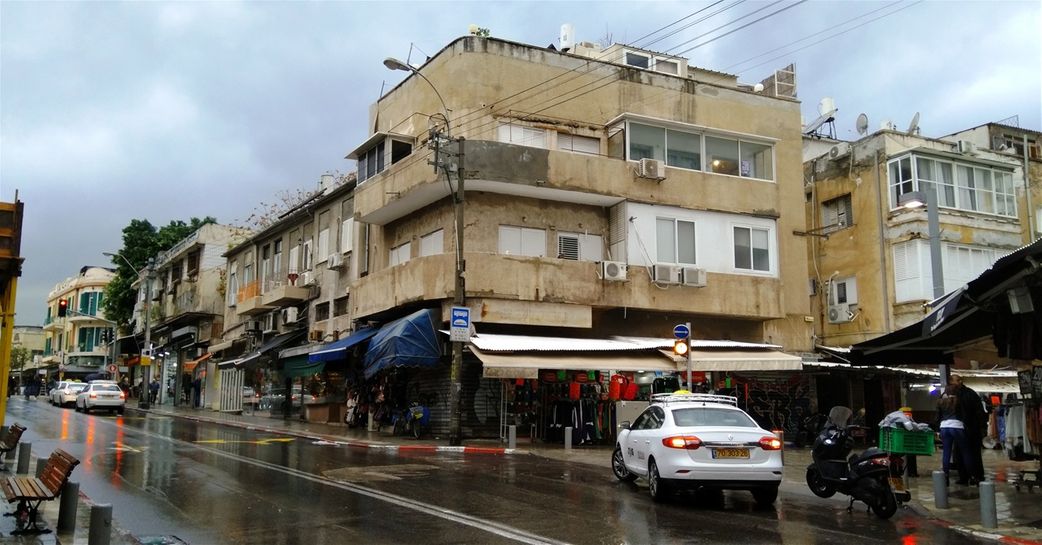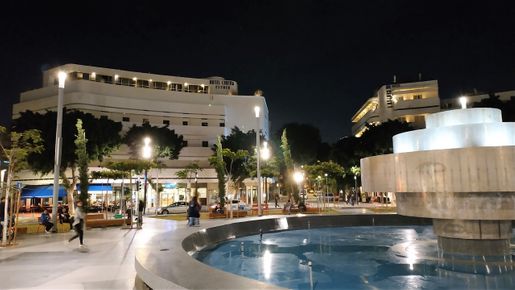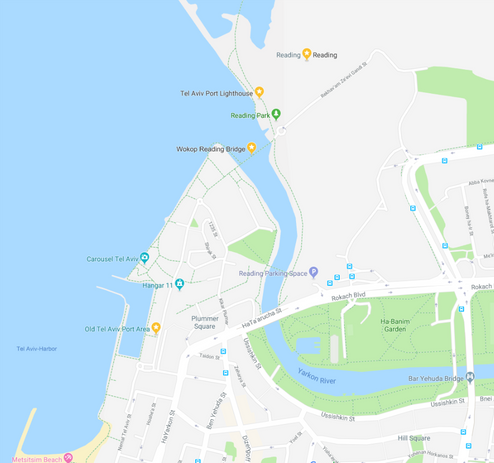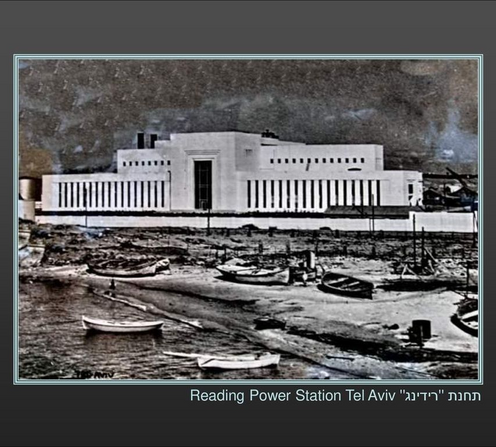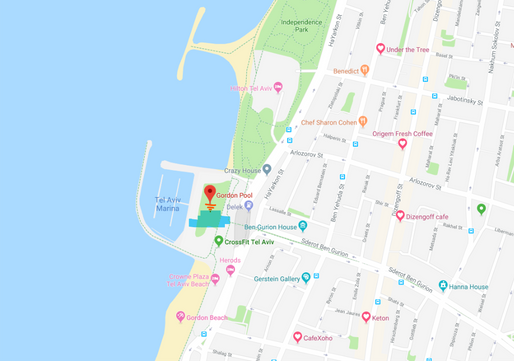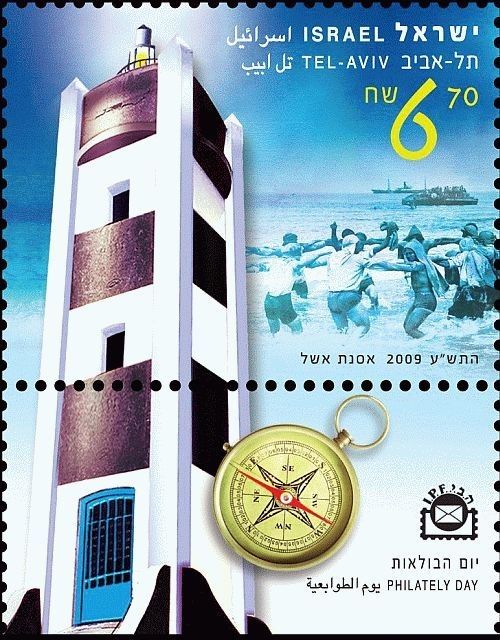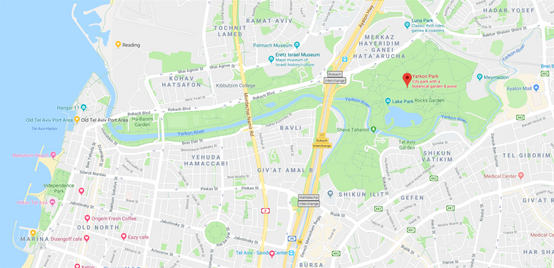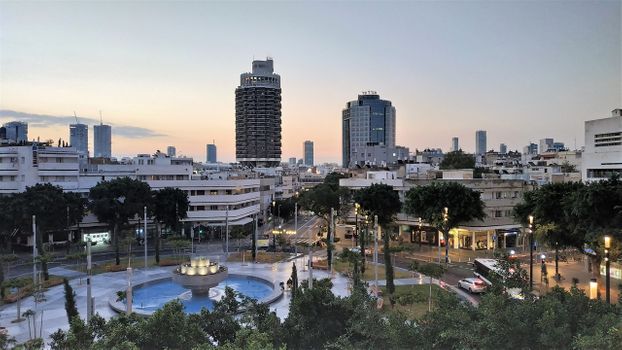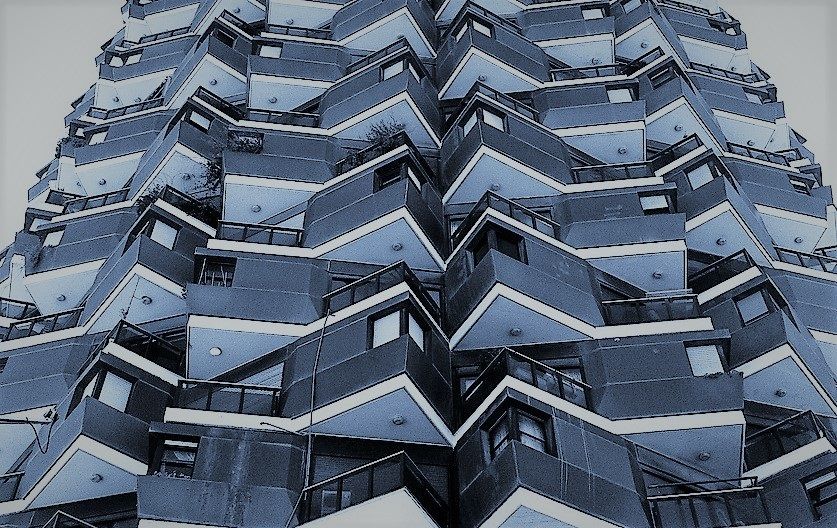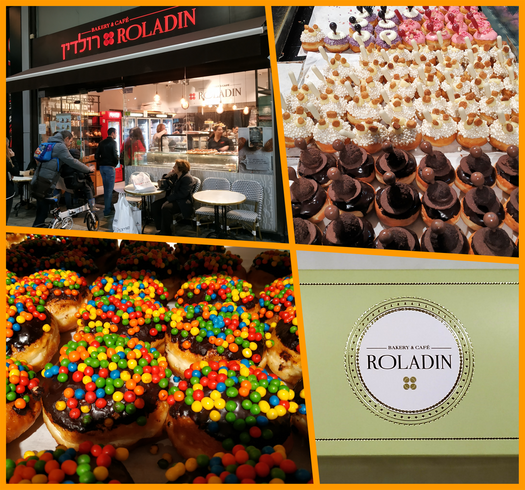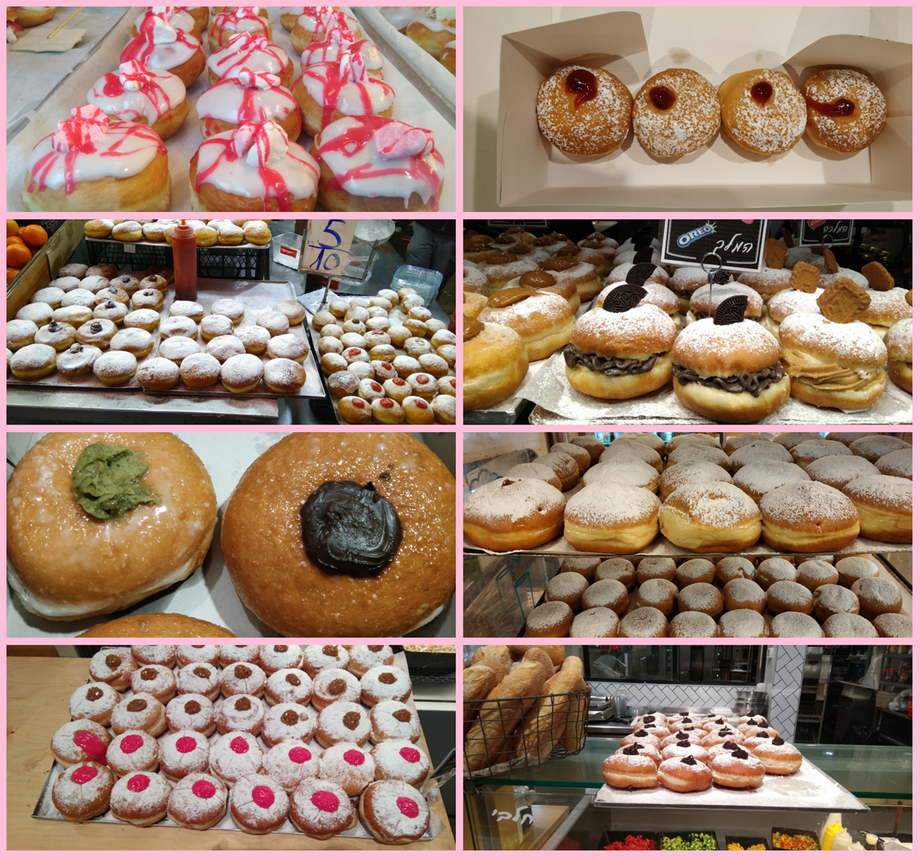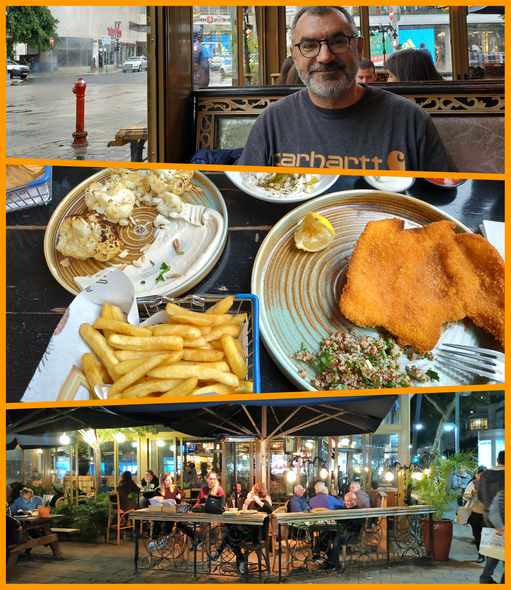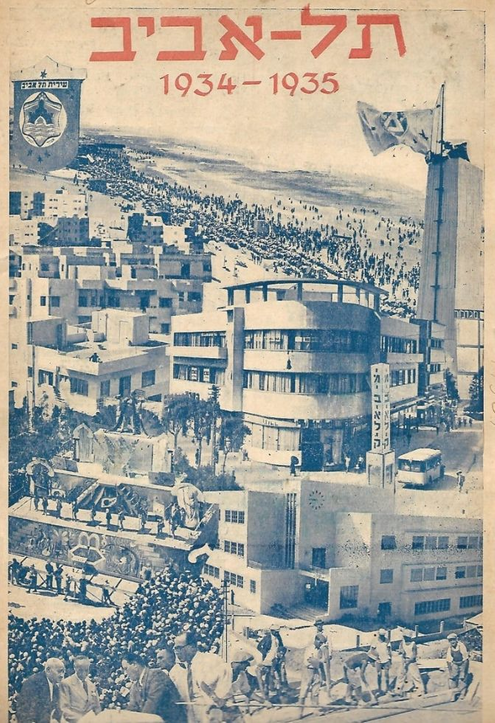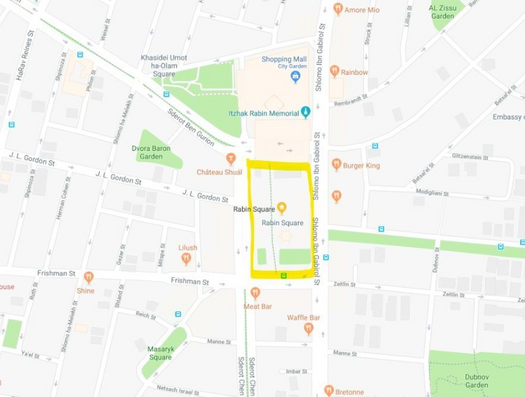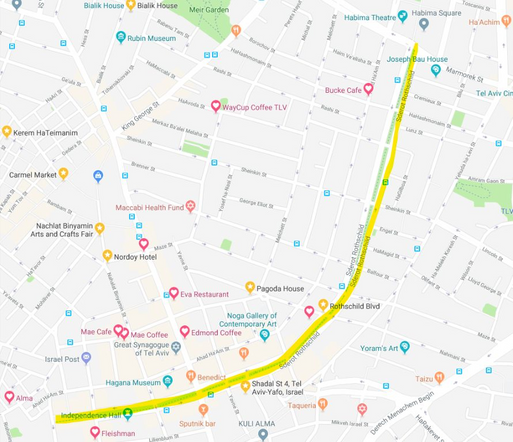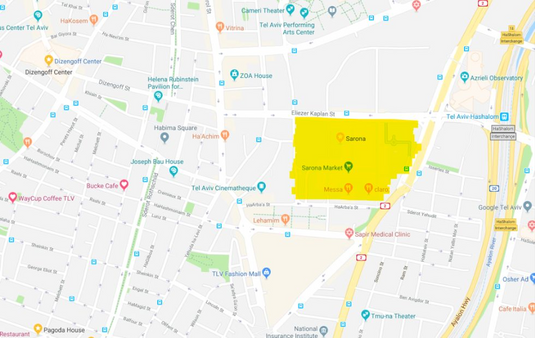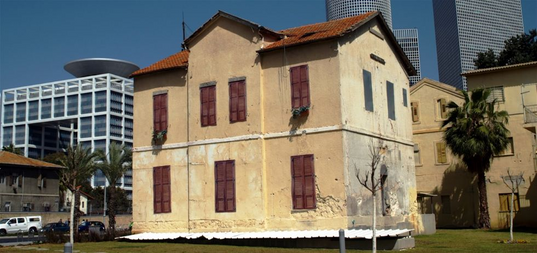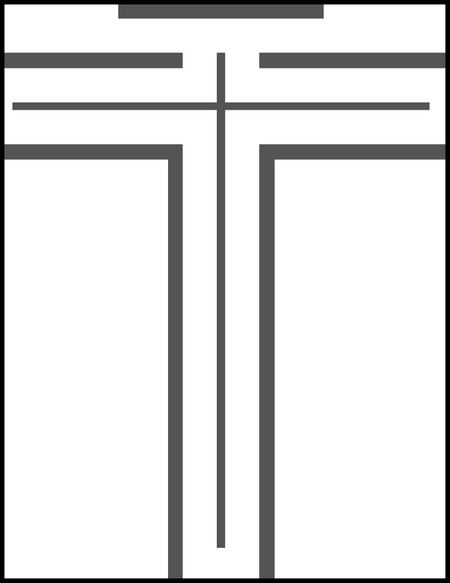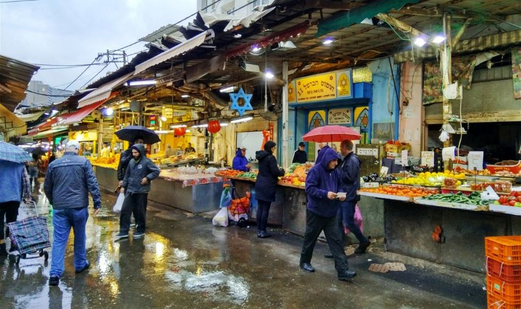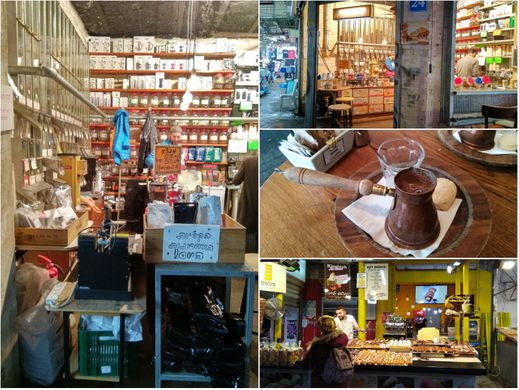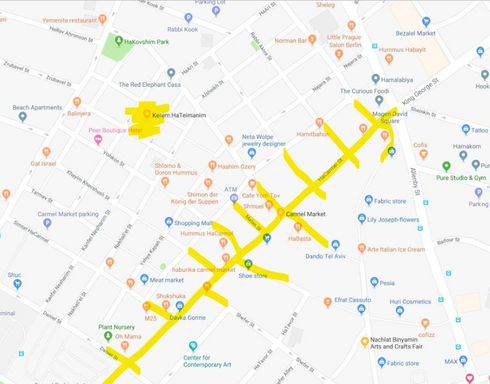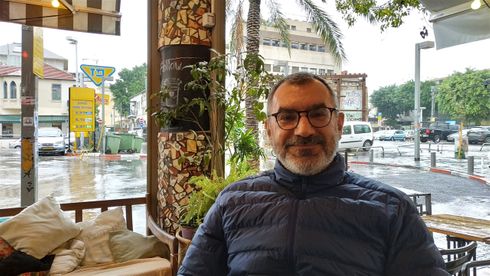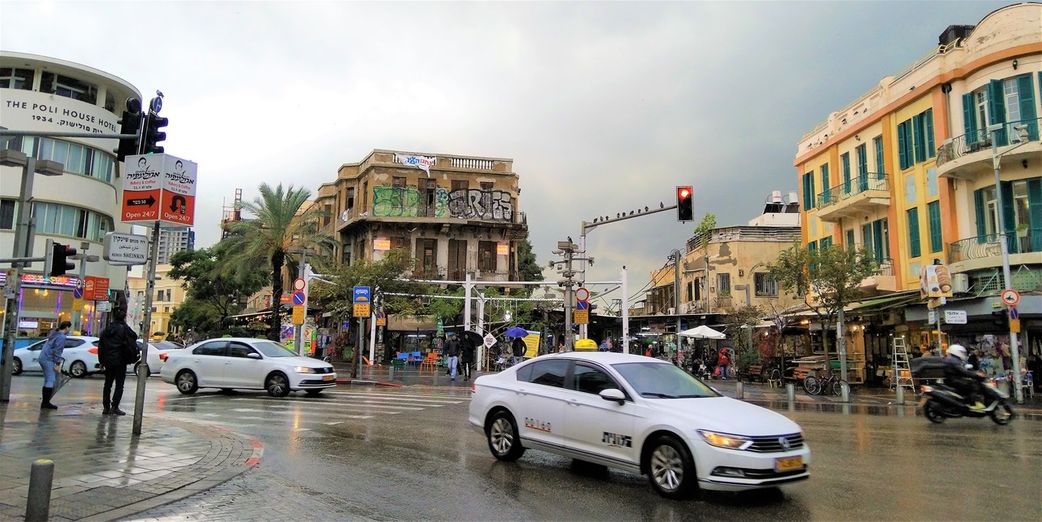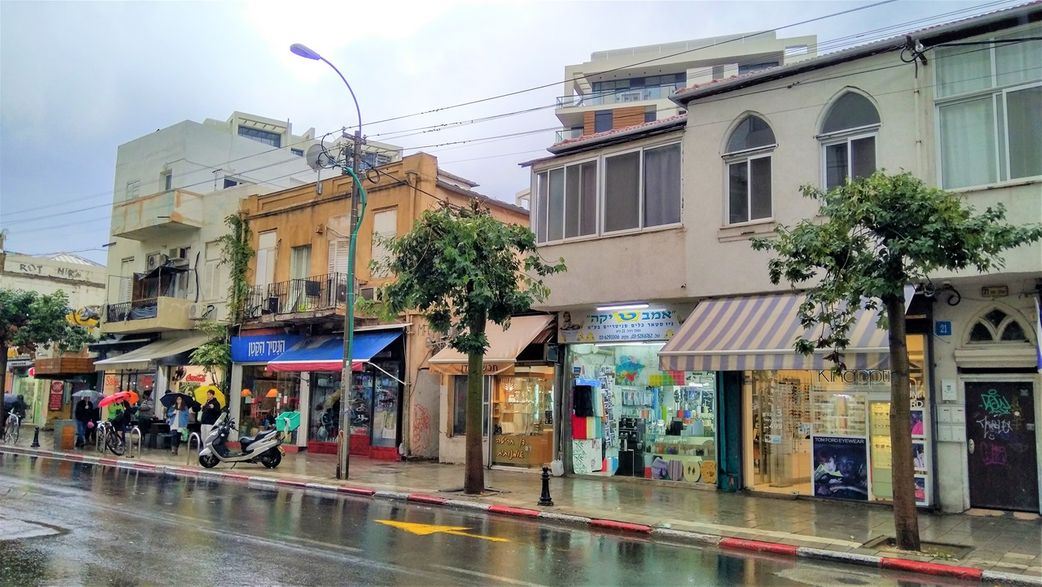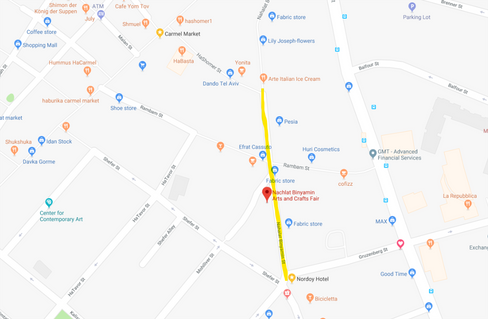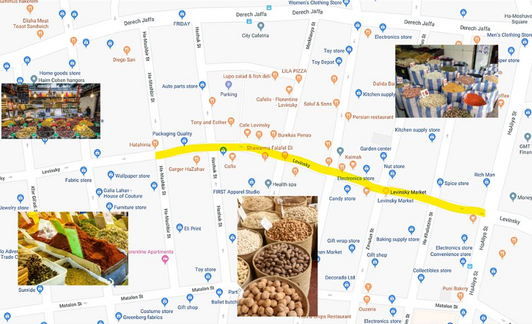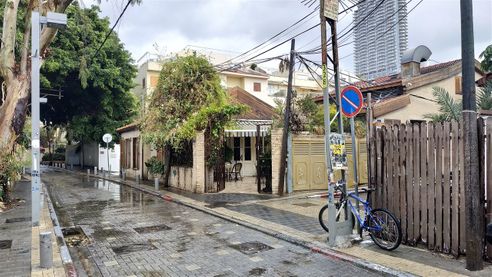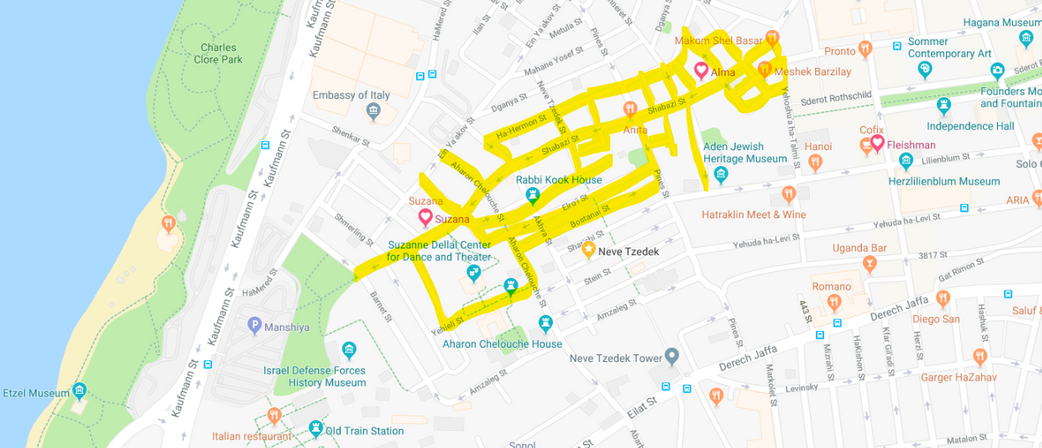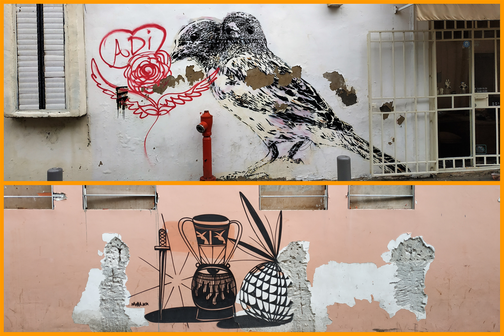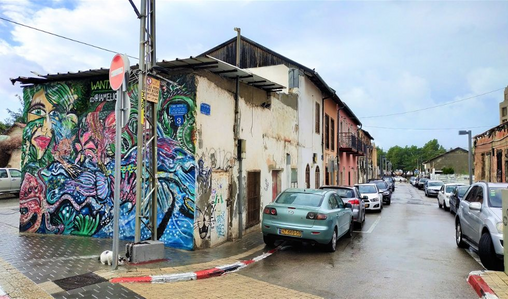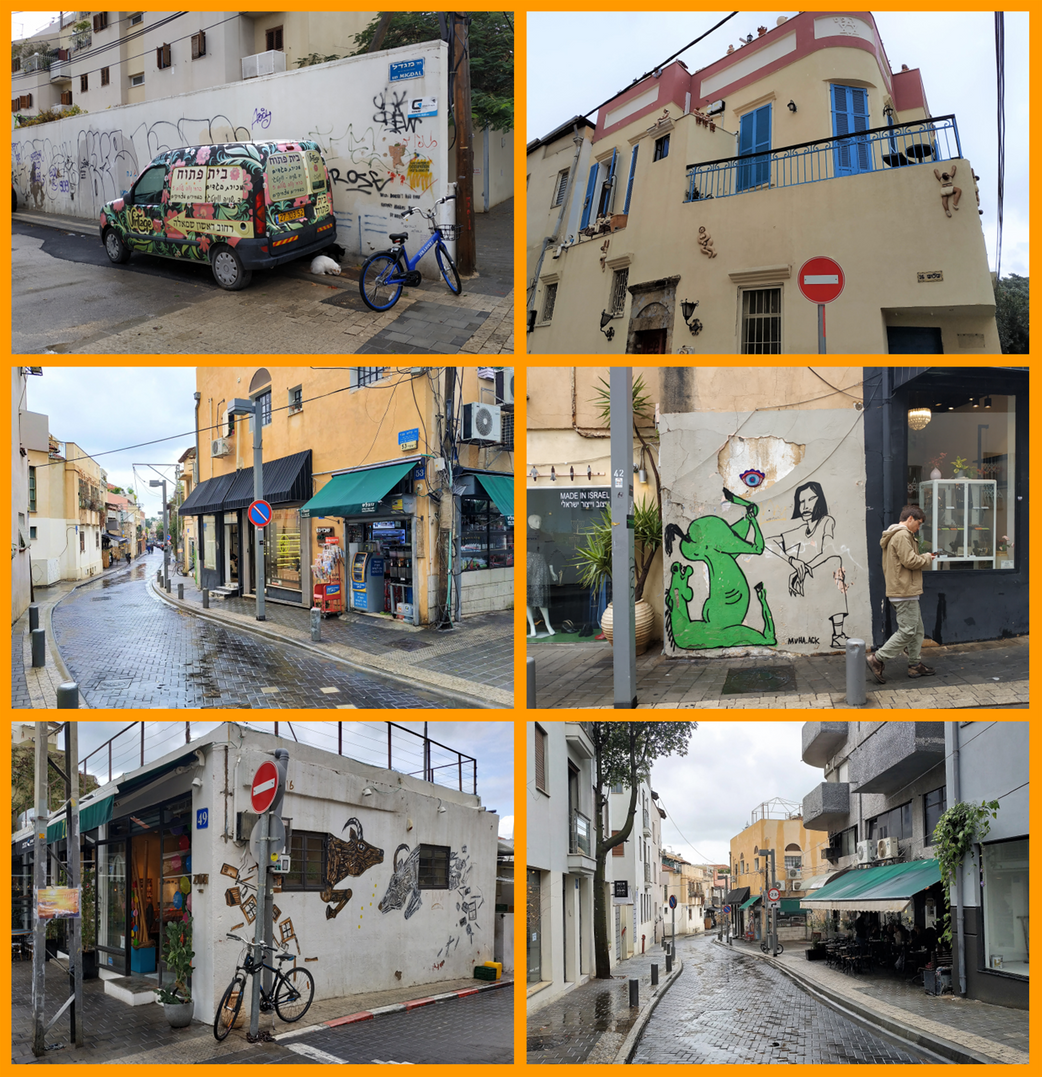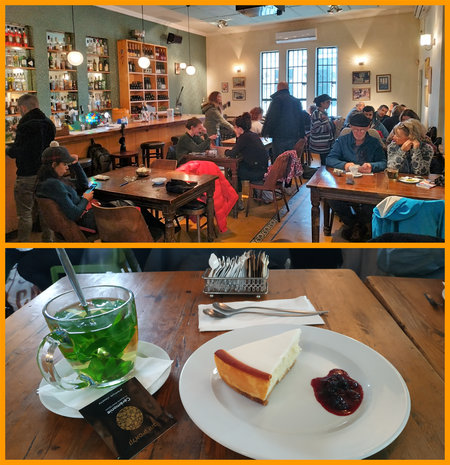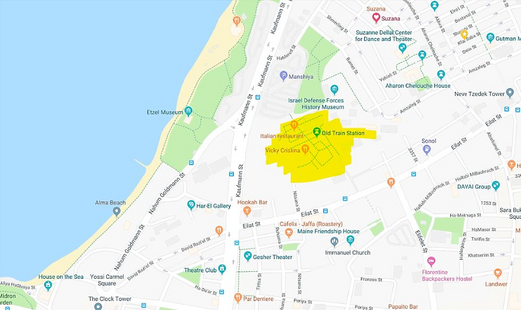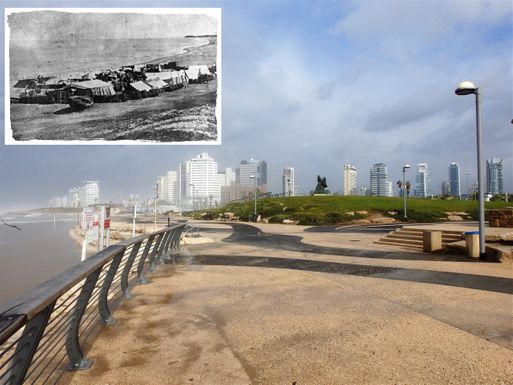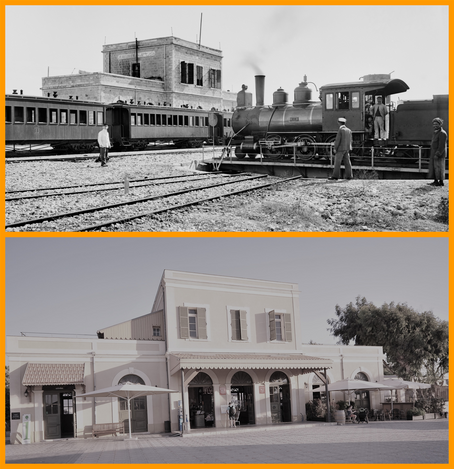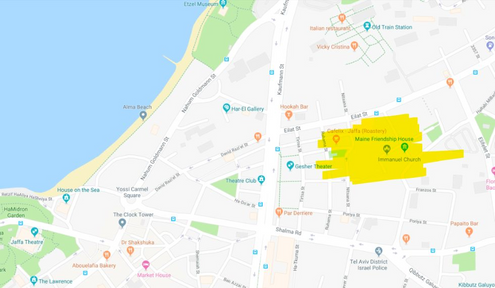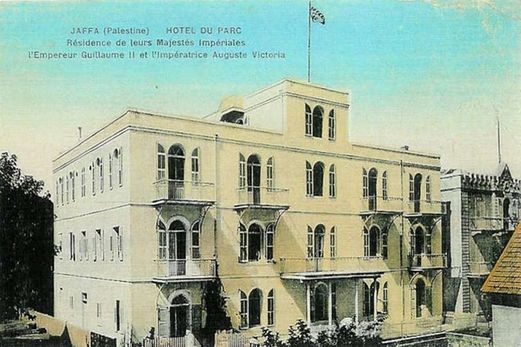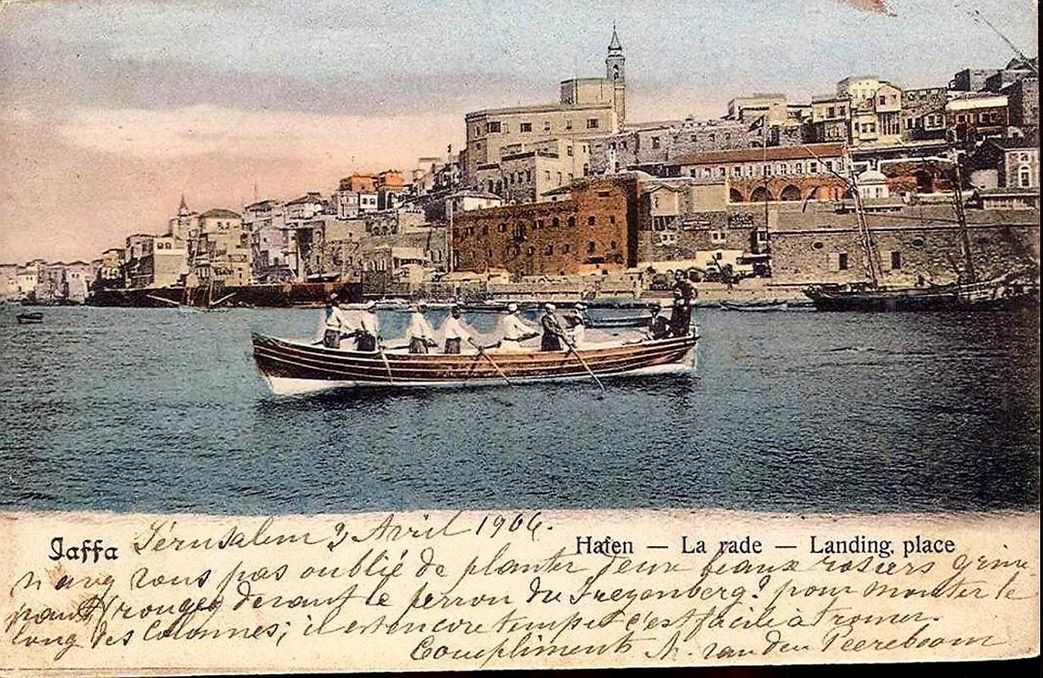👎This page does not look like any of my other pages, as my photo production during the three days I stayed in Tel Aviv was very poor, due to the heavy rain...👎
(*) This article has been translated into Spanish and can be found following this link: "Tel Aviv Con Perro"
A bit of history
Tel Aviv (or Tev Aviv-Yafo, which is the official municipality name) is the economic and technological center of Israel. Located on the eastern mediterranean coast, it was founded in 1909 by the Yishuv (*) as a modern housing estate on the outskirts of the ancient port city of Jaffa (Yafo), then part of the Jerusalem province of Ottoman Syria. Its name means "Ancient Hill of Spring" or “Tell of Spring” (**).
(*) The term "Yishuv" came into use in the 1880s, for the Jews living across the Land of Israel, then comprising the southern part of Ottoman Syria, and continued to be used until 1948. The term is used in Hebrew even nowadays to denote the Pre-State Jewish residents in the Land of Israel.
(**) Tell (in the Middle East) means an artificial mound formed by the accumulated remains of ancient settlements. (From the Arabic word 'tall=hillock').
Tel Aviv skyline, seen from Alma beach.
Tel Aviv and Jaffa (Jafo, in Hebrew) were merged into a single municipality in 1950, two years after the Israeli Declaration of Independence, which was proclaimed in the city. Tel Aviv's White City, designated a UNESCO World Heritage Site in 2003, comprises the world's largest concentration of International Style buildings, including Bauhaus and other related modernist architectural styles.
The "Old New Land" ('Altneuland', in the original German; 'Tel Aviv', in Hebrew) is a utopian novel published by Theodor Herzl, the founder of political Zionism, in 1902. It was published six years after Herzl's political pamphlet, "Der Judenstaat" (The Jewish State) and expanded on Herzl's vision for a Jewish state in the Land of Israel, which helped Altneuland become one of Zionism's establishing texts. It was translated into Hebrew by Nahum Sokolow as 'Tel Aviv', a name then adopted for the newly founded city.
Getting to know the city
Tel Aviv, is a very relaxed and tolerant city, in contrast with the very conservative and religiously overwhelming Jerusalem. The moment you put your foot in the city you have the feeling that you have been here before. Everything is casual, but organized. The club-café vibes of the city are omnipresent and the beach culture is what really defines the city.
"Tel Aviv Beach", 2011 Israel stamp.
From afar, the city gives the idea of a skyscraper city, as tall buildings "grow" for kilometers along the mediterranean coast. The skyline reminds very much that of a north American megalopolis. However, when you get into the central part of the city, you realize that this is a very “down to earth city” as most buildings are not more than 3-storey high.
Downtown Tel Aviv.
When in central Tel Aviv, you have the feeling that you are in a town with treelined streets and open-air cafés instead of a big city. The city is not only recognized as "the world's sexiest city" (sic!) or “the Mediterranean Capital of Cool” or a global leader in tech startups, but also as one of the greenest cities worldwide. Groves of massive trees line the oldest streets of Tel Aviv. These trees belong to the ficus family and they look just gorgeous, especially the older ones with their branches and roots connected. This kind of trees produce propagating roots that grow downwards as aerial roots. When the roots reach the ground they grow into trunks, making it difficult to tell the original tree from its offshoots. There's nothing more beautifoul than these trees after a heavy rain when their foliage gets a bright shiny green color!
Tel Aviv is not cheap, neither for food or accommodation. The standard of living is equivalent to that of western Europe or North America, so expect to pay as much as in a big European city.
A ficus tree in a street of Tel Aviv.
When to visit
The best time to visit Tel Aviv is undoubtedly Spring and Automn, when the weather is just delightful. Summers in Israel can be rough, but do not worry: bring light clothes (or very tiny ones), speedos, lots of sunblock, hats and of course your surfboard. After all, Tel Aviv is synonymous to the beach culture. Summer is the best time of the year to take a stroll along the boardwalk, which extends for kilometers, or to play “matkot”, the paddle-and ball beach game that we all people in eastern mediterranean love to play. Tel Aviv is a very gay friendly city, so if you are visiting during June, you’ll have the opportunity to see the city at its most celebratory period. Tel Aviv’s annual Gay Pride parade takes place during the second week of June, and everything turns very gay and colorful.
Surfers in the grey winter waters of Tel Aviv.
I visited Tel Aviv in winter. Certainly not the best period to visit, because during December-January it rains. And when I say rain, I mean RAIN. Be prepared for days of heavy rain and strong winds: bring a good umbrella with you, not the 5$ one you buy from street vendors!
Me with Ben Gurion, inside “Ben Gurion” International Airport.
Moving around
Tel Aviv has a very good network of buses (operated by the Dan cooperative: www.dan.co.il), so you will never need a car to drive around. A single ride costs 5.90 NIS and can be purchased from the driver, who even can give you changes...so, no worries about where to find tickets, etc. The only problem with buses is that destinations and stops are only written in Hebrew…no English at all. Τherefore, the best way to find easily your way around with buses is to use a smartphone app, like Moovit. Moovit works also in any browser by using this link: https://moovitapp.com .
Bus routes hanging on the wall of a bus stop in Tel Aviv.
Arriving in Tel Aviv
The main entrance to Israel is the “Ben Gurion” International Airport, located between Tel Aviv and Jerusalem. It takes about 30 minutes to drive the 20km from here to Tel Aviv city center. There are two terminals at the airport: terminal 1 (for domestic and international low-cost flights) and Terminal 3 (for most international flights), so check with your airline which is the correct terminal for you.
Taxis are very regulated in Israel, so prices are fixed from/to the airport. Two persons with two pieces of luggage will need 142 ₪ (NIS or just “shekel”). 1 USD is pretty much equivalent to about 4 ₪.
Alternatively, you can use the train or bus. Israel Railways (which run all trains in Israel) connect Ben Gurion Airport station in Terminal 3 with four train stations in Tel Aviv. However, be aware that the stations in Tel Aviv are on the edge of the city and a bus/taxi is required to get to almost all hotels. The train costs 19 NIS per person.
There are also many Shuttle buses, which for 16NIS will take you to most hotels in Tel Aviv.
A bustop in central Tel Aviv.
When, we westerners, travel to countries which use an alphabet different than the Latin one, we certainly expect a high level of difficulty, if not to be completely lost in translation. This is also the case for Israel if you are not familiar with Hebrew. The good news is that here almost everyone speaks English; even the older people will be able to communicate in some English. Young people are fluent in English.
Note: no buses operate on the Sabbath, i.e. from Friday evening to Saturday evening. However, some service taxis operate on the Sabbath, following specific bus routes.
Honestly, in any case, the best way to move around in Tel Aviv is on foot, because the place is really flat and distances are relatively short. Besides, there is not a better way to see all the locals walking their dogs, than moving on foot. Yes, dogs…lots of dogs! It is said that Tel Aviv has the largest number of dogs per capita, which means that it is a very dog-friendly place.
Advice: do not forget that walking your dog is one of the best ways to meet people and even flirting around! A well-known truth as old as time...💋
Bicycles are super cool and Telavivians know hot to be cool. And we all know that cool people also use electric scooters and roller blades. Like most modern cities of today, Tel Aviv has public bicycles which everyone can rent any time of the day. Green-colored bicycles are available for rent at many places in the city.
Besides buses and taxis, in Tel Aviv, one can use something between these two, which is called “sherut” or shared taxi. Sheruts are small buses (mini vans), that work like buses, with the same routes, route numbers and stops. The sherut does not stop at every stop, but has to be hailed. Enter into it and go find your seat. Pass the fare to the passenger in front of you, who will keep passing it forward till it gets into the driver’s pocket. Of course, you should do the same for fellow passengers. You have to inform the driver about your upcoming stop, otherwise he will not stop. Sheruts are a bit difficult to use by tourists, because one needs to know where to stop, etc.
A sherut that follows the No5 bus route. No5 is one of the very basic and useful bus lines, which connects the two bus station of Tel Aviv.
The official language of Israel is modern Hebrew. Hebrew goes back to the 10th century BC, at a form we call Biblical Hebrew. Hebrew ceased to be an everyday spoken language somewhere between 200 and 400 AD, displaced mainly by Aramaic.
The Hebrew language
Then, in the 19th century, it was revived as a spoken and literary language and became the lingua franca of Palestine's Jews, and subsequently of the State of Israel.
Israeli stamp depicting Eliezer Ben-Yehuda.
The revival of the Hebrew language as a mother tongue was initiated by the efforts of Eliezer Ben-Yehuda, who joined the Jewish national movement and in 1881 immigrated to Palestine, then a part of the Ottoman Empire. Due to his efforts the British Mandate of Palestine recognized Hebrew as one of the country's three official languages (English, Arabic, and Hebrew), in 1922. Its new formal status contributed to its diffusion.
Hebrew should not be confused with Yiddish, which is the historical language of the Ashkenazi Jews. It originated in Central Europe, during the 9th century, providing the nascent Ashkenazi community with a High German-based vernacular fused with elements taken from Hebrew and Aramaic, as well as from Slavic languages and traces of Romance languages.
Tel Aviv Architecture
The “White City” of Tel Aviv (inner city) is the largest collection of Bauhaus style buildings in the world. It is recognized by UNESCO as a World Heritage Site for this reason. As well as the Bauhaus architecture which characterizes the city, Tel Aviv also has a great collection of eclectic-style buildings, and many newer buildings which slot in-between and create an interesting architectural mosaic.
The city of Tel Aviv was founded in 1909. The founders of the city, obviously turned for advice to several city planners to decide the form of the new city. In November 1909 the first families moved out of Jaffa and by the end of the month 50 families had moved in.
In March 1910, Akiva Weiss (one of the founders of the new city) settled with his pregnant wife and 7 children in his new house on Herzl Street. Soon Weiss’s wife gave birth to Tel-Aviv’s first-born child, a girl named: Ahazabit.
By the end of 1909 the first houses were built on Rothschild Boulevard. The houses were designed in Neo-Classic Romantic Style, examples of which include the “Twin House” on the corner of Strauss and Mazeh streets and the “Levine” house on Rothschild Boulevard.
From 1924 until 1929 the building-designs were in the Eclectic-style, classic architecture with an Oriental aspect and old-Jewish ceramic motifs. Famous examples of such buildings are: the "Pagoda House" on the confluence of Melchett, Nachmani and Montifori streets, the "Rivka Grinwald House" on Shadal str, the "Hotel Nordav" on Nahalat Binyamin str, the "Balik House" on Bialik str, the "Great Synagogue" on Alenbi Str, and the "Old City Hall" at Bialik square.
Completed in 1926, Tel Aviv’s Great Synagogue is also the architectural brainchild of Yehuda Magidovitch and is considered an early example of how he peppered his eclectic style buildings with Art Deco themes. The building’s outer facade was done by architect Ze’ev Rechter at the end of the 1930s as part of a masterplan to build an Italian-style plaza around the building.
"Bauhaus-like" modern building in central Tel Aviv.
The "Pagoda House".
The 1929 Eclectic-style building on Ahad Ha'Am Str (No21). Today, it houses a branch of the Bank of Jerusalem.
From 1930 until 1938 more than 4.500 buildings were designed in the International Style, in Tel Aviv called Bauhaus. These beautiful Tel Aviv white-washed houses were designed with deep, rounded balconies, flat roofs and horizontal windows to cut the glare of the Mediterranean. The architects were directly inspired by the buildings of the Bauhaus School but had to adopt this north European style to the mediterranean climate conditions.
Bauhaus architecture is omnipresent in the White City.
The ideal Tel Aviv apartment should be cool in summer and comfortably warm in the winter. Given the lack of thermal insulation of that time, the architect needed to use natural features such as the sun and the winds for warming and cooling respectively. The rooms facing the west were cooler in the morning, those which face east were better ventilated in the afternoon. This is why the living rooms face west and the bedrooms face east. These were the type of considerations that guided the Bauhaus architects for their plans of the unit apartments.
After 1948 thousands and thousands of new immigrants came to Tel Aviv and the buildings (in their thousands) were designed in a “cheap kind” of Bauhaus Style.
A fine example of Bauhaus architecture, on Dizengoff Square.
A fine example of Bauhaus architecture. A residential house on Dizengoff Square.
Not all Bauhaus buildings are big any fancy. Whole neighborhoods are made of “Cheap kind” of Bauhaus Style buildings.
Bauhaus architecture around Dizengoff Square. The Famous Esther Cinema is on the left (now a hotel).
Places to visit
One does not visit Tel Aviv to see either the Parthenon, the Forbidden City or the Louvre Museum. The city is very new to has one of those “one hundred attractions you must see before you die”. Instead, it is the city's atmosphere and cool vibes that attract people here.
Nevertheless, if you have time, there are several historical and not-so-historical places to visit and enjoy.
Old Tel Aviv Port, Reading Power Station & the Reading Lighthouse on the map.
In 2003 UNESCO declared the inner-city of Tel Aviv a World Heritage Site, saving the 4,500 Bauhaus-buildings (as well as the earlier buildings) from their destruction. Over the past few years, mass-restoration of Tel Avivs’s traditional buildings has been undertaken, whilst modern glass skyscrapers have sprung up across the city to give a unique and stunning contrast.
Tel Aviv Port, also known as Namal Tel Aviv, founded (in 1936) south of the point where the Yarkon river meets the sea, and soon grew into the biggest in the country. This flourishing situation didn’t continue, however, and as containerized shipping became the standard way of transporting goods, bigger ports were built elsewhere, and Namal Tel Aviv became derelict. In the 1990’s and 2000’s, the port went through a major transformation into an area of leisure, with the big old hangers converted into restaurants, shops, and nightclubs.
Today, the Namal is an area of culture, entertainment and leisure activities. A huge wooden deck acts as a promenade running along the seafront. Shaped like waves in the sea, this unique promenade becomes crowded, especially when the weather is good, as well as the rest of the port. It is a very vibrant place, and has something for everyone.
Reading Power Station & the Reading Lighthouse
From Namal Tel Aviv, by crossing the pedestrian Wokop Reading Bridge over Yarkon River, one reaches the Reading Power Station and the Reading Lighthouse. The Lighthouse was built in 1935 and the power plant three years later. Both buildings are preserved as architectural landmarks of importance and the surrounding area has been developed to accomodate the visitors. The power station chimney is one of the landmarks of Tel Aviv and can be seen from afar.
Gordon Pool on the map.
Yarkon Park (Park Hayarkon)
A 2009 Israeli stamp depicting the Reading Lighthouse.
The Gordon Pool
Just south of Namal, next to Tel Aviv marina, there is a very popular pool. The Gordon Pool is not just a pool… it is a unique facility! This more than half-a-century-old pool is located at Gordon beach and is filled with sea water. It is drained and refilled every day with sea water pumped in from a mile off shore. On-site of this Olympic-size pool there are other recreational facilities, such as a health club.
The "green lung" of Tel Aviv, which opened to the public in 1973, in unbelievably huge. The Yarqon River with its glistening waters runs through the park, and spills into the Mediterranean Sea. Most of the park lies north of the river, but the south bank has a nice portion of it as well.
The park is an excellent place for physical activities of all kinds: walking, jogging, cycling, boating, kissing, picnicing, playing basket ball, etc. The park is clean, but the river is not appropriate for swimming.
Yarkon Park (Park Hayarkon) on the map.
Dizengoff Square, Center and Tower
Dizengoff Street is one of the oldest streets of Tel Aviv and a main artery. It is a commercial street lined with trees and full of restaurants and cafés. The north part of the steet is spread with many small Israeli designer shops. The street is named for Meir Dizengoff, Tel Aviv's first mayor.
At the lower part of Dizengoff street stands the iconic Dizengoff Square, which was inaugurated in 1938 and considered as the center of the city.
Recently the square was brought back to its original flat design, cancelling the 1978 plit-level configuration. In the center of the square there is a big fountain with a mix of fire and water.
During my visit to the city, I stayed at the "White House" hotel, which is housed in one of the beautifully restored all-white Bauhous buildings of the square. My room was on the top floor and had huge windows over the square.
Dizengoff Square in the dawn. The Dizengoff Tower is the barrel-shaped building in the middle of the picture.
Not far from the square stands the Dizengoff Center, the first shopping mall in Israel, which was inaugurated in 1977. One can get lost inside the center because it is built like a maze. On Thursday and Friday afternoons there is a food market at the bottom floor of the mall with all kinds of restaurants. Amateur chefs sell traditional dishes for decent prices. The mall made the news on March 4, 1996, when during the Jewish holiday of Purim, a suicide bombing here killed 13 people, many of them youngsters in costume.
Detail of the Dizengoff Tower.
I was lucky to visit Tel Aviv during the celebrations of Hanukah. And I say lucky, because I just adore donuts, which happens to be the Hanukah sweet treat! At the street level of the western building of Dizengoff Center, on Dizengoff street (No 49), there is a donut paradise. Roladin Bakery and café, had the most beautiful show window covered with multicolored donuts. I just could not decide what to bring back at my hotel room! Of course, Roladin bakes all kind of sweet delights, but that was donut week and I was so satisfied …or, should I say ecstatic?!
Roladin Bakery & Cafe.
My Hanukah donut collection!
The Dizengoff Tower, a residential tower which rises atop of the northern part of the mall. This innovative for its period building was built like a Lego structure: interconnecting blocks were assembled on site and put one uppon the other, one apartment at a time. It is also nicknamed "the shoe boxes".
Between the Dizengoff Square and Dizengoff center (77, Dizengoff St) is located the Bauhaus Center Tel Aviv, which was established in 2000.
Bauhaus Center's goal is to expand public recognition of the “White City” as a unique architectural and as marvellous piece of culture. The center holds a gallery with a permanent collection and changing exhibitions, conducts tours of the city for architecture buffs and publishes books dedicated to the subject. Visit its shop for beautiful souvenirs and more.
"Centro" bar-restaurant.
Rabin Square
The largest public square in Israel is located by the footsteps of the city hall. This square hosts many public demonstrations and events, often with tens of thousands of participants in attendance. The square is named after former PM Yitzhak Rabin, who was assassinated here during a peace rally in 1995. A memorial in his memory is located at the northeast corner of the square. Around the artificial pond there are beach chairs for visitors to hang out.
Location of Rabin Square.
Rothschild Boulevard
Rothschild Boulevard is one of the most important and iconic streets in Tel Aviv. It is a commercial center, with major financial institutions lining the street, a cultural center, a culinary center, and a leisure center.
This long and curved boulevard, located in the heart of the White City of Tel Aviv, starts from Habima Square in the east (around which are located: the Habima Theater, the Israel’s National Theater, the Hall of Culture of Tel Aviv, the Helena Rubinstein Pavilion for Contemporary Art and the Fredric Mann Auditorium, the home of the Israel Philharmonic Orchestra) and finishes at Independence Hall (the house of Meir Dizengoff, where Israel’s Declaration of Independence was signed in 1948) in the south.
Bauhaus, White City,1930s Poster.
Some meters north of Bauhaus Center Tel Aviv, on the corner of Dizengoff and Tchernikhovski Streets, stands one of the most beautiful cafe-restaurant in this part of the city: Centro-Tel Aviv. Centro is a very charming place full of young and lively people. Located on the corner of two wide streets, it has a closed-with-glass big patio, as well as an open-air sitting area on Tchernikhovski Street, making Centro one of the best restaurants to sit and watch people passing by, while enjoying your cappuccino or colorful cocktail. Try a juicy burger with mushrooms or a crispy schnitzel (is it a pork schnitzel?!) served with french fries, cauliflower and tahini.
Rothschild Boulevard on the map.
The boulevard is very wide and a park (which used to be a dry stream) rans along its middle. This park-garden is popular with dog walkers, bikers, coffee & fruit shake aficionados who enjoy their espresso at one of the coffee kiosks or people who just sit and watch the world go by.
Hagana Museum, which features exhibits on the history of the Jewish Yishuv defense force, is also located here. There are some excellent buildings along the boulevard, such as the Levin House (no 46), as well as noteworthy art installations and sculptures, such as Nahum Gutman's mosaic (no 1), Dizengoff on his horse (no 16) and the Green Chair (no 43).
Sarona
Sarona is a newly renovated complex in the heart of the city, originally a German Templar Colony, the site sits at the heart of what is a new central business district of the city, in which 33 original Templar buildings have been restored, and today house boutique stores, artist galleries, quaint cafes, and some of the city’s hottest restaurants and bars.
Opened in early 2014, Sarona is popular for its namesake covered market, a trendy hub of gourmet food stores selling local cheeses and cured meats and restaurants by big-name Israeli chefs. Sarona Market, is Tel Aviv’s new culinary destination which can rival Barcelona’s La Boqueria, London’s Borough Market, and New York’s Chelsea Market.
Sarona was established in 1871 by German Templars, Christians who headed to Holy Land and created a ‘colony’. The Templar Colony became a leisure and commerce destination until in the 1930’s a number of the Templars became engaged in activities with the Nazi Party.
Location of Sarona Market.
Templer houses in Sarona.
The British, who controlled the land at the time, declared the German Templars ‘enemy nationals’ following the outbreak of WWII, and the Templars were exiled to Germany and Australia. With the Templars gone, the British occupied the colony, fortifying it, and creating there a military base which was attacked numerous times by the Jewish underground groups in the pre-State era. The British handed the Sarona compound to the Jewish leaders in December 1947, and the camp was renamed “Machane Yehoshua”.
The Templers
The Temple Society (Tempelgesellschaft in German) is a German Protestant sect with roots in the Pietist movement of the Lutheran Church. Members refer to themselves as Templers.
The word Templer is derived from the concept of the Christian Community as described in the New Testament, where every person and the community are seen as temples in which God's spirit dwells. There is no connection to the Medieval Knights Templar.
The Templers were expelled from the Lutheran Church in 1858 because of their millennial beliefs. Their aim was to realize the apocalyptic visions of the prophets of Israel in the Holy Land.
They settled in Palestine as early as 1868 and established many settlements. Because of their Affiliation with the Third Reich, though, they expelled from the Holy land after 1941 mainly to Germany or Australia. Since the formation of the State of Israel, in 1948, Templers cannot return there.
The Tempelgesellschaft cross.
Carmel Market and Kerem HaTeimanim
Kerem HaTeimanim is a predominantly religious neighborhood and one of the very few places in ultra-secular Tel Aviv, where you can feel the atmosphere of Shabbat. The winding alleys of the traditional Kerem Ha Teimanim neighborhood are home to old-school restaurants specializing in Yemenite cuisine, like malawah flatbreads and hearty meat dumpling soups, as well as numerous hummus and falafel eateries. Here you can find the best hummus in the city!
HaCarmel street, Carmel Market.
Walk the main street of the market, HaCarmel street, all the way to the big car parking lot to get the full color out of it. “Amalia Café”, a tiny but very cozy café, with a small outside sitting porch, is located at a street perpendicular to the beginning of HaCarmel street and the perfect place for a delicious Arab/Turkish cardamom black coffee
Carmel Market. “Coffee at the market” (left & top right). Arab coffee at 'Amalia Café' (middle right).
Location of Carmel Market and Kerem HaTeimanim.
Therefore, it is of no surprise that stalls (called "basta") at nearby lively Carmel Market (called by locals just "the shuk") sell everything from spices to salted fish and from nuts to sweet temptations, while unpretentious bars in and around the market serve up craft beer and wine, and homey restaurants serve the best traditional dishes in town.
At “Amalia Café”.
At “Coffee at the market”, in the heart of the market (on the corner of HaCarmel and Rabbi Meir streets) not only you can buy every kind of coffee beans and moka coffee makers, but you also can have a coffee shot in one of its two little tables. Further down, you can have some delicious tacos at “Viva Mexico” cantina-restaurant or some real shakshuka at “Shakshuka” cantina-restaurant next door.
The beginning of HaCarmel street and Carmel Market.
Nahalat Binyamin Arts and Crafts Market
Not far from Carmel Market, the Nachalat Binyamin Market opens twice every week and is one of the best places in the city to find original (and not that original), handmade items.
Nachalat Binyamin street houses mostly fabric stores. Here takes place Nachalat Binyamin Market twice a week.
Location of Nahalat Binyamin Arts and Crafts Market.
Levinsky Market
During the 1930s, Tel Aviv was home to a small working-class group of Jews, which immigrated from Thessaloniki, in northern Greece. David Florentin (Δαυίδ Φλωρεντίνος) was considered the leader of the group which, together with his pioneering activities for developing the city, earned him the nickname 'David Palestina’.
The neighborhood they settled in is called today Florentin (located south of Rothchild Boulevard), after David's nephew Solomon Florentin, who was the first contractor in the area and before long, a range of spice shops and eateries opened up across the neighborhood, specializing in Balkan cuisine. That’s how this marketplace came to be what we know today.
Located in one of the oldest neighborhoods in Tel Aviv, Nachalat Binyamin Market features a good range of different arts and craft products presented by many artists who set up every Tuesday and Friday (from 10:00 to 17:00-18:00) to offer their sometimes fascinating (sometimes tacky and ordinary) creations to the public. Get hand-decorated hamsas and mezuzahs to bring back home as gifts for friends and family.
Levinsky Market runs along Levinsky Street, beginning at the corner of HaAliya Street and ending near HaMashbir Street.
With the creation of the State of Israel, an influx of Iranian immigrants brought new tastes and herbs from Persian cooking. And as the population grew, so did the market place, developing from its nuts and spice stalls into a bustling, commercial marketplace with luxury stores and gourmet restaurants. Today, the Levinsky Shuk spreads across Levinsky Street, between HaAliyah Street and Herzl Street. Among the stores to visit are dried fruits and nuts, bakeries, delicatessens and restaurants. The magic of this market place lies in its many legendary tales of culinary growth and discovery, stories that continue to appeal to local residents and well-known chefs alike. Wander around and check the street art. The graffiti in Florentin is a giant, free art exhibition.
Shabazzi Street.
Neve Tzedek
The charming neighborhood of Neve Tzedek is the first official Jewish community established (1887) outside Jaffa's walls and one of the oldest in the city. It is filled with quaint buildings showcasing both the old Bauhaus buildings in their original form mixed with newer structures and homes.
Location of Neve Tzedek.
On the main street, Shabazzi Street, you can find avant-garde fashion, jewelry boutiques, handcrafted pottery and soaps, and a wide variety of cafes and restaurants. Regardless of the time of day, you will always see Tel Aviv’s most stylish people sitting outside enjoying a coffee and a cigarette and in the evenings the vibe is mellow with many wine bars, jazz bars, and cozy cocktail joints.
Neve Tzedek murals.
Shabazzi Street - the lower end (close to the beach).
Neve Tzedek, which can better be accessed from the lower end of Rothschild Boulevard, houses the Suzanne Dellal building where the famous Batsheva Dancers practice and perform. From the artsy buildings, charming alleyways and shops to the overflowing bougainvillea flowers and all the people in the area you are sure to snap a few great photos.
Neve Tzedek.
While here, do not forget to visit the beautiful “Sipur Pashut” bookshop, at no 36 of Shabazi Street. Small in size yet large in offerings, the store stands out because of its unusual book selection and upstairs gallery where one can curl up on a couch and just read. Here I bought “an activity city guide for creative travelers” titled “Tel Aviv City Stories”. Alma café (at no 55 of Shabazi St) offers great breakfasts, while the beautiful old-fashioned café “Suzana” at no9 of the same street (just behind the Suzanne Dellal Center for Dance and Theater) offers good cakes and more.
Café “Suzana”.
Hatachana, the Old Railway Station
HaTachana, the Hebrew name for the old Jaffa railway station has recently been transformed into one of Tel Aviv’s smartest public spaces. Located between the Tel Aviv Beach and Neve Tzedek. HaTachana has a brilliant selection of cafés, restaurants, and interesting boutiques ranging from fashion to wooden toys, all in an enviably realistic historic setting.
HaTachana was originally built in 1892 as the terminus for the Jaffa-Jerusalem railway. When the railway closed (in 1948), the site fell into decay and was an unused piece of prime real estate.
Location of the Old Train Station
The American-German Colony
The American Colony is situated in the south of the Tel Aviv, not far from Jaffa, between the Florentin and Noga neighborhoods. This small (just two streets long) and quaint area has a very unique look, feel, and history. Walking down the cobblestone streets, you’ll be surprised to see wooden homes, a stained-glass church, and a mix of both high-end building projects as well as deteriorated & abandoned structures.
The main picture shows the landing place as it is today (where the Etzel Museum stands today). The small black and white picture shows the same beach the days after the settlers have just arrived in 1886.
After a few years, many settlers dispersed to Europe or returned to Maine and new German settlers, from the Templar Movement, purchased much of the land and buildings which the Americans had constructed. In 1904, the Germans added the Immanuel Church, which still stands today, along with the Beit Immanuel Hostel, which was the main office, school, and community hall of the German Temple Society. Today, it is a guesthouse for Protestant pilgrims, but its beautiful garden and rooms are open to all.
During WWI and WWII, the British authorities deported many of the Germans or put them under police supervision, and much of the area was deemed enemy property. With the establishment of the State of Israel, the land fell into the custody of the new Israeli government. Religious places (such as the Immanuel Church), remained in public custody, but secular structures fell under the jurisdiction of the government.
Hatachana, the Old Railway Station, then (top) and now (bottom).
The transformation into one of the city’s hottest spots has not ignored its heritage and the complex includes a jumble of refurbished rail cars, freight terminals and train tracks to nowhere. There’s even a disused cement factory (circa 1905), that has been repurposed as retail space.
Location of the The American-German Colony.
The history of The American Colony in Tel Aviv dates back to 1886 when a group of over 150 Christian Americans from Maine and New England decided to follow their faith and vision and settle in Palestine. Led by George Adams, these families made a 42-day journey and landed where the Etzel Museum stands today, on the beach between Tel Aviv and Jaffa. They brought with them the wood and materials to revive their homes in the New England style. When they were granted permission from the Ottomans, settled in what has come to be called “The American Colony.”
The Beit Immanuel Hostel, when it housed a fashionable hotel – German Kaiser Wilhelm II stayed here in 1898 – owned by Baron Plato von Ustinov, grandfather of the actor Peter Ustinov.
Over the years, the neighborhood became neglected and deteriorated. Today, you’ll see many crumbling ruins if you visit the area, however, there has a been a surge of restoration and development in recent years, which brings a new spotlight and hope to the old decaying buildings.
JAFFA
The Jaffa port 1896.
The most visited "atraction" of Tel Aviv-Yafo is Jaffa. Jaffa is the old sibling of Tel Aviv. Located just south of Tel Aviv, is the old city from where the Jews left to establish the new city, about a century ago. Jaffa is famous for its association with the biblical stories of Jonah, Solomon and Saint Peter as well as the mythological story of Andromeda and Perseus, and later for its oranges. The history of the area is very old and tumultuous. Spend at least a long afternoon to stroll around the old streets of Jaffa.
Plan your walk around Jaffa by following this link:
I stayed in Tel Aviv for three days only. This short period is not enough even to scratch the surface of the city. I certainly need to be back soon!

